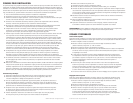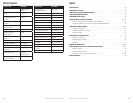
4 © 2011 Polk Audio—all rights reserved © 2011 Polk Audio—all rights reserved 5
ENGLISH
INTRODUCTION
Thank you for your purchase of a Polk Audio PA D Series amplifier. Each PA D Series amplifier is designed
to be the leader in its class offering the most power, advanced features, and extreme ease of use. In high-end
sound systems or high SPL systems, PA D Series amplifiers will give you years of trouble-free performance.
• PA D2000.2—250W x 2 RMS @ 2 Ohms; 125W x 2 RMS @ 4 Ohms; 500W x 1 RMS Bridged @ 4 Ohms.
Note: Improper installation will not only limit the performance of your Polk Audio PA D Series amplifier but also
potentially compromise the reliability of this amplifier. To ensure proper sonic results and component reliability,
please refer to your authorized dealer for installation assistance or advice. If you decide to perform the installation
yourself, be sure to read the entire manual before beginning the installation (see Installation Guidelines on page 8).
RECORD THIS INFORMATION FOR YOUR RECORDS
Model:__________________________________________________
Serial Number:____________________________________________
Date of Purchase:__________________________________________
WHAT’S IN THE BOX
• PolkAudioAmplifier •TerminalBlockAdaptor
• PhillipsScrews(4) •Owner’s Manual
• Online Registration Card
Important Note: If anything is missing or damaged, or if your Polk Audio PA D Series amplifier fails
to operate, notify your dealer immediately. We recommend keeping your original carton and packing
materials in case you need to ship the unit in the future.
WARNING: LISTEN CAREFULLY
Polk Audio amplifiers, loudspeakers and subwoofers are capable of playing at extremely high volume levels,
which could cause serious or permanent hearing damage. Polk Audio accepts no liability for hearing loss,
bodily injury or property damage resulting from the misuse of its products. Keep these guidelines in mind
and always use your own good judgment when controlling volume. For more about safe volume levels,
go to: www.osha.gov/dts/osta/otm/noise/standards_more.html
INTERNAL BRIDGING
Terminals that can be used in bridging mode are identified by the black boxes above each terminal.
In the PA D2000.2, the two black boxes work together to create an internally bridged hookup.
TOOLS OF THE TRADE
Listed next are the majority of the tools required to perform an installation.
Having the proper tools will make the installation that much easier.
• Phillipsheadscrewdriver •Solderless,crimp-onconnectorsandacrimpingtool
• Electricdrilland3/16"and1/8"drillbits •Safetyglasses
• Permanentinkmarkerorpencil •DMMorVOM
• Safetyglasses •Nylontiestraps
• Wirestrippersandcutters •Wirecrimper
• Electricaltape •Grommetsforpassingwiresthroughmetalcarwalls
END PANEL LAYOUTS
PA D2000.2 Line Level Inputs/Outputs/Controls
1. Status LEDs (on top of amplifier): Power and Protection—Power will illuminate to indicate
the amplifier is on and operating normally; protection will illuminate if the amplifier shuts down
due to short circuit, DC offset, or overheating detected by onboard protection circuitry.
2. HPF, FULL, BPF Switch—Selects full range, high pass filter, or band-pass filter. The HPF setting
attenuates low frequencies and is used with mid-range speakers and tweeters. The FULL setting
does not attenuate any frequencies and is for full range speaker systems. The BPF setting allows
you to use both the high pass filter and low pass filter, and it is for use with mid-range drivers.
3. (a) Low-Pass Frequency Button—Sets the frequency of the crossover at a range of either
50Hz - 500Hz or, when FREQ x 10 is engaged, to 500Hz - 5000Hz.
(b) LPF Variable Control—Adjusts the low pass filter frequency to attenuate frequencies
above the setting on the control.
4. (a) High-Pass Frequency Button—Sets the frequency of the crossover at a range
of either 20Hz - 400Hz or, when FREQ x 10 is engaged, to 200Hz - 4000Hz.
(b) HPF Variable Control—Adjusts the high pass filter frequency to attenuate frequencies
below the setting on the control.
5. Level Control—Adjusts the gain of the left and right channels to match the output
voltage from your head unit.
6. Line Level Inputs—Accepts line level input from a head unit, preamplifier or, equalizer.
7. Line Level Outputs—Provides a full range signal for easy connection to additional amplifiers.
LLRR
BRIDGED
BRIDGED
BRIDGED
BRIDGED
BRIDGED
RL FL
RR
REAR
FRONT
FR
RR FR
RL FL
RL FL
SUB
RR FR
RR FR
SUB
RL FL
PA D2000.2
PA D4000.4
PA D5000.5
L
R
L
INPUT OUTPUT
R
LPF
LPF
HPF LEVEL
BPF
FULL
HPF
X-OVER
HPF
X-OVER
FREQ x 10
FREQ x 1
FREQ x 10
FREQ x 1
20Hz400Hz 6V 200mV50Hz 500Hz
GND
12VREM
25A25A
LLRR
BRIDGED
L
R
L
R
LPFHPF LEVELLPFHPFLEVEL
HPF
BPF
FULL
HPF
BPF
FULL
ST
4CH
FRONT
REAR
X-OVER
X-OVER
FREQ x 10
FREQ x 1
FREQ x 10
FREQ x 1
50Hz 500Hz 50Hz 500Hz20Hz 400Hz 20Hz 400Hz6V 200mV 6V 200mV
CHANNEL
MODE
GND
12VREM
40A
35A
RL FL
RR
REAR
FRONT
FR
RR FR
RL FL
INPUT
SUB 1
SUB 2
SOURCE
SUB
INT
LEVEL
SUB
SONIC
LPF
REMOTE LEVEL CONTROL
INPUT
FR RR
FL RL
4CHST
CHANNEL
MODE
LPFHPF LEVEL
BPF
FULL
HPF
HPFFULL
HPF LEVEL
FRONT
REAR
6V 200mV
6V 200mV
20Hz 38Hz 40Hz 220Hz
40Hz 4000Hz 6V 200mV40Hz 400Hz80Hz4000Hz
SUB
GND
12VREM
40A40A
RL FL
SUB
RR FR
RR FR
SUB
RL FL
2876543
PA D1000.1
1432 5
27
654b4a3a
PA D2000.2
3b
1432 5
21211
PA D4000.4
4a 5a 9a 10a
4b 5b 9b 10b6 7 8
14323
8
5
2
1
PA D5000.5
109 11 15 1612 13 14
1432
1
1
1
3 4 6 75 5


















